
|
Astronomy Picture Of the Day (APOD)
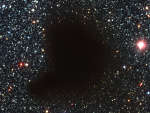 Molecular Cloud Barnard 68
Molecular Cloud Barnard 68
23.03.2008
Where did all the stars go? What used to be considered a hole in the sky is now known to astronomers as a dark molecular cloud. Here, a high concentration of dust and molecular gas absorb practically all the visible light emitted from background stars.
 Cat s Eye Hubble Remix
Cat s Eye Hubble Remix
22.03.2008
Staring across interstellar space, the alluring Cat's Eye Nebula lies three thousand light-years from Earth. One of the most famous planetary nebulae in the sky, the Cat's Eye (NGC 6543) is over half a light-year across and represents a final, brief yet glorious phase in the life of a sun-like star.
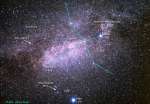 Where is HD 189733
Where is HD 189733
21.03.2008
The star cataloged as HD 189733 is a mere 63 light-years away. Its location is indicated in this deep, wide-angle image of the sky centered on the northern constellation of Cygnus. Considering the many...
 Sunset: Planet Earth
Sunset: Planet Earth
20.03.2008
Today, the Sun crosses the celestial equator heading north at 0548 UT. Known as the equinox, the geocentric astronomical event marks the first day of spring in the northern hemisphere and autumn in the south.
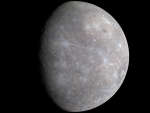 Mercury in Accentuated Color
Mercury in Accentuated Color
19.03.2008
The colors of Mercury are subtle but beautiful. At first glance, our Solar System's innermost planet appears simply black and white, but images that include infrared colors normally beyond human vision accentuate a world of detail. One such image, shown above, was acquired by the robotic MESSENGER spacecraft that swung by Mercury in mid-January.
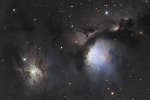 M78 and Reflecting Dust Clouds in Orion
M78 and Reflecting Dust Clouds in Orion
18.03.2008
An eerie blue glow and ominous columns of dark dust highlight M78 and other bright reflection nebula in the constellation of Orion. The dark filamentary dust not only absorbs light, but also reflects the light of several bright blue stars that formed recently in the nebula.
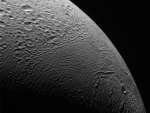 Thirty Thousand Kilometers Above Enceladus
Thirty Thousand Kilometers Above Enceladus
17.03.2008
What does the surface of Saturn's ice-spewing moon Enceladus look like? To help find out, the robotic Cassini spacecraft now orbiting Saturn was sent soaring past the cryovolcanic moon and even right through one of Enceladus' ice plumes. Cassini closed to about 52 kilometers during its closest encounter to date.
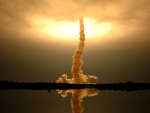 Endeavour to Orbit
Endeavour to Orbit
16.03.2008
Birds don't fly as high. Airplanes don't go as fast. The Statue of Liberty weighs less. No species other than human can even comprehend what is going on, nor could any human just a millennium ago. The launch of a rocket bound for space is an event that inspires awe and challenges description.
15.03.2008
Hiding near the Sun, a slender crescent Moon is a difficult but rewarding sight. Look to the right (scroll right) and you can spot one in this twilight panorama across the Bosporus Strait and along the skyline of the historic city of Istanbul. Recorded on March 8, the Moon is a mere 22 hours young.
 Endeavour into the Night
Endeavour into the Night
14.03.2008
Blasting into a dark night sky, the Space Shuttle Endeavour began its latest journey to orbit in the early morning hours of March 11. In this stunning picture following the launch, the glare from...
|
January February March April May June July August September October November December |
|||||||||||||||||||||||||||||||||||||||||||||||||